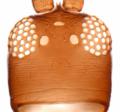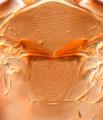Aeolothrips occidentalis
Recognition data
Distinguishing features
Female fully winged. Body and legs uniformly brown; antennal segment III yellow with extreme apex lightly shaded, IV yellow in basal half or more; fore wings with posterior margin dark band extending from near apex to (but not including) clavus, with no transverse dark band. Head with no long setae; pronotal posteromarginal setae not stouter than pronotal discal setae. Fore tarsus apically with stout recurved ventral hamus. Antennae 9-segmented, sensorium on segment III about 0.3 as long as segment, on IV almost 0.5 as long as segment, V–IX forming a single unit with V much longer than VI–IX and usually as long as IV. Metanotum reticulate medially. Marginal setae on sternites arising at or close to margin; sternite VII supernumerary paired setae arising a little in front of margin.
Male not known.
Related and similar species
Described from four females, A. occidentalis is a member of a species-complex in which the forewing bears a longitudinal dark area along the posterior margin. It apparently differs from A. kuwanaii in having antennal segment IV paler. Just over 90 species are placed currently in the genus Aeolothrips, of which more than 50 are from the Palaearctic Region (mainly Europe), and 28 from the Nearctic (mainly western USA). Only two species are recorded from the Neotropics; the one from Chile is probably the same as A. fasciatus, and one from Panama is probably not a member of this genus (Mound & Marullo, 1996).
Taxonomic data
Current valid name
Aeolothrips occidentalis Bailey
Original name and synonyms
- Aeolothrips occidentalis Bailey, 1951: 63
Family placement
Aeolothripidae
Biological data
Life history
Presumably flower-living as a facultative predator with a mixed diet of pollen and the larvae of other thrips.
Host plants
Swept from grasses.
Tospoviruses vectored
None
Crop damage
None
Distribution data
Area of origin
Western USA
Distribution
California






